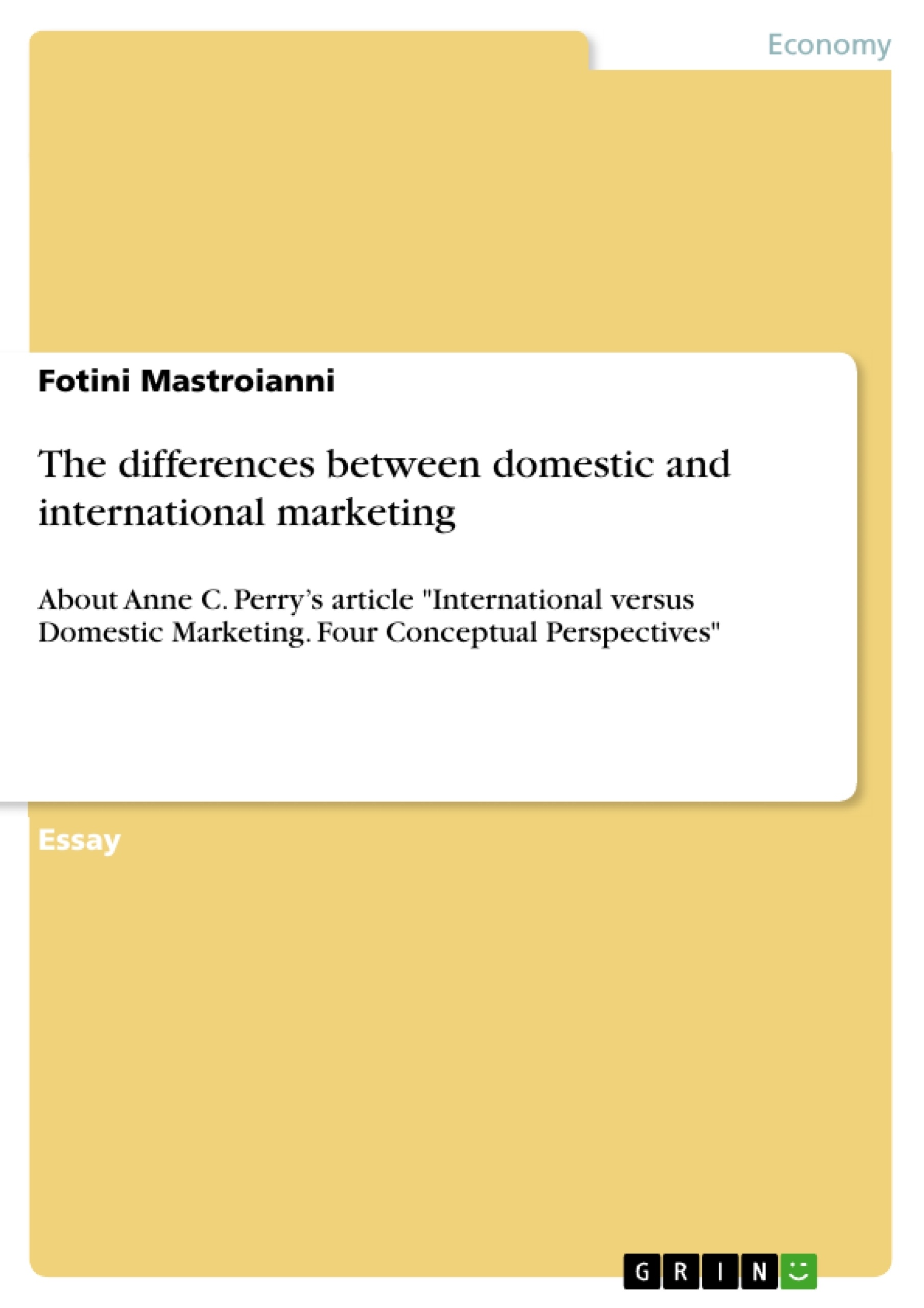The article that is going to be discussed in the present essay is “International versus Domestic Marketing: Four Conceptual Perspectives” by Anne C. Perry (1990). The reason why this article was selected is that due to the current global financial crisis, the issues of globalization and entering international markets is an imperative action by the companies that want to acquire a substantial and sustainable competitive advantage. The purpose of the article is to show the differences between domestic and international marketing and recapitulate academic literature on the subject based on the four views of International Marketing.
Table of Contents
- Introduction
- International versus Domestic Marketing
- Conclusion
Objectives and Key Themes
The objective of this preview is to provide a comprehensive overview of Anne C. Perry's article, "International versus Domestic Marketing: Four Conceptual Perspectives," focusing on its key arguments and themes without revealing major conclusions. The preview analyzes the article's comparison of domestic and international marketing, examining its evolution and implications.
- Differences between domestic and international marketing
- Evolution of international marketing strategies
- Perlmutter's typology of managerial orientations in international business
- Four conceptual perspectives on international marketing: extension of domestic marketing, collection of national marketings, generic marketing, and global marketing
- The impact of globalization on marketing strategies
Chapter Summaries
Introduction: This introductory section sets the stage for the analysis of Perry's article, comparing it to similar works by Steenkamp & Hofstede (2002) and Sheth and Parvatiyar (2001). It highlights the importance of studying international marketing in the context of the global financial crisis and emphasizes the article's aim to examine various aspects of international versus domestic marketing, suggesting areas for further research.
International versus Domestic Marketing: This chapter forms the core of the article, exploring the differences between domestic and international marketing based on a review of theoretical perspectives by Bartels, McInness, Kotler, Levitt, and Porter. The chapter analyzes Perlmutter's typology, which categorizes companies' international business orientations into ethnocentrism, polycentrism, and geocentrism, adding a fourth perspective – global marketing – to create a four-part framework for understanding the evolution of international marketing. The chapter then delves into each of these four perspectives, discussing their implications and limitations, such as the potential neglect of exogenous factors in generic marketing. It contrasts approaches like the standardization of products (as advocated by Levitt) with the need for localization in certain contexts.
Keywords
International marketing, domestic marketing, globalization, Perlmutter's typology, ethnocentrism, polycentrism, geocentrism, global marketing, standardization, localization, market segmentation, cross-cultural marketing.
Frequently Asked Questions: International versus Domestic Marketing: Four Conceptual Perspectives
What is the purpose of this HTML document?
This HTML document provides a structured preview of Anne C. Perry's article, "International versus Domestic Marketing: Four Conceptual Perspectives." It offers a comprehensive overview including the table of contents, objectives, key themes, chapter summaries, and keywords, allowing for a thorough understanding of the article's content without revealing major conclusions.
What are the key themes explored in Perry's article?
The article explores the differences between domestic and international marketing, tracing the evolution of international marketing strategies. Key themes include Perlmutter's typology of managerial orientations (ethnocentrism, polycentrism, geocentrism), the four conceptual perspectives on international marketing (extension of domestic marketing, collection of national marketings, generic marketing, and global marketing), and the impact of globalization on marketing strategies.
What are the four conceptual perspectives on international marketing discussed in the article?
The article analyzes four perspectives: 1) Extension of domestic marketing (treating international markets as extensions of the domestic market); 2) Collection of national marketings (treating each international market as unique and requiring separate strategies); 3) Generic marketing (developing a standardized global marketing strategy); and 4) Global marketing (adapting a global strategy while recognizing and responding to local market differences).
How does the article relate to existing literature?
The introduction compares Perry's work to similar works by Steenkamp & Hofstede (2002) and Sheth and Parvatiyar (2001). The main body draws on theoretical perspectives from various scholars including Bartels, McInness, Kotler, Levitt, and Porter.
What is Perlmutter's typology, and how is it relevant to the article?
Perlmutter's typology categorizes companies' international business orientations into ethnocentrism (home country-oriented), polycentrism (host country-oriented), and geocentrism (world-oriented). The article uses this typology, adding a fourth perspective – global marketing – to create a framework for understanding the evolution of international marketing strategies.
What are the key differences between domestic and international marketing highlighted in the article?
The article delves into the complexities of adapting marketing strategies to international markets, contrasting approaches like the standardization of products (as advocated by Levitt) with the need for localization in various contexts. It highlights the challenges of navigating cultural differences and the impact of exogenous factors on marketing effectiveness. The article emphasizes the need for considering factors beyond those relevant in domestic marketing.
What are the key words associated with the article?
Key words include: International marketing, domestic marketing, globalization, Perlmutter's typology, ethnocentrism, polycentrism, geocentrism, global marketing, standardization, localization, market segmentation, cross-cultural marketing.
What is the overall conclusion of the article (as suggested by the preview)?
The preview does not reveal the article's major conclusions but suggests areas for further research are identified in the introduction.
- Quote paper
- Fotini Mastroianni (Author), 2013, The differences between domestic and international marketing, Munich, GRIN Verlag, https://www.grin.com/document/355388




